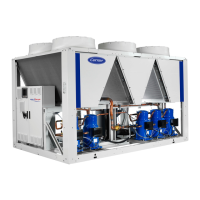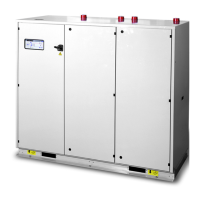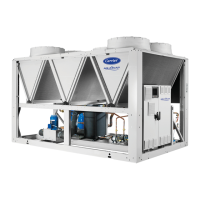8.7 - Frost protection
IMPORTANT: Damage caused by frost is not covered by the
warranty.
The plate heat exchanger, the pipes and the hydraulic module
pump(s) can be damaged by frost. The components of the unit
(heat exchanger, pipes, hydraulic module) are protected by
following the recommendations below. Protection of the remainder
of the system is the responsibility of the installer.
The plate heat exchanger and all the components of the hydraulic
circuit can be protected against freezing by draining the entire
machine completely, checking that there are no retention points.
If this is not possible, the plate heat exchanger and all the
components of the water circuit can be protected against freezing:
■ Down to -20°C by heaters and heat trace cables (tted as an
option on the exchanger and internal pipe system) supplied
automatically (for units without the hydraulic module)
■ Down to -20°C by heaters and heat trace cables (tted as an
option on the water type heat exchanger and internal pipe
system) supplied automatically and pump on/o activation (for
units with hydraulic module)
Never power o the heaters for the water type heat exchanger
and the hydraulic circuit or pump, as they will no longer be
providing frost protection.
To ensure they continue to receive power, the main disconnect
switch for the unit or the customer's circuit and the auxiliary circuit
breaker for the heaters must be left closed (see the wiring diagram
for the location of these components).
To protect units with a hydraulic module from freezing, water must
be circulated in the water circuit by the pump, which is activated
at regular intervals.
Combination of options for periods when the machine is in
standby.
Ambient unit
temperature range
30RB/RBP 170R-950R
or 30RQ/RQP 165R-1040R
Without option 116 With option 116
> 0 °C to 51 °C - -
-20 °C to 0 °C
Option 41
or
Suitable antifreeze
solution
(glycol, for example)
Option 42A/B
(1)
or
Suitable antifreeze
solution
(such as glycol)
(1)
(1) Allow the pumps to circulate. If there is a valve, install a bypass (see diagram
for winter position).
If the system is isolated by a valve, it is imperative to install a
bypass as indicated below.
Winter position
Unit
Water network
Closed
Closed
Open
IMPORTANT REMINDERS:
Depending on the atmospheric conditions in your region,
you need to:
■ Add an appropriate antifreeze solution agreed by the
manufacturer (maximum of 45%) to protect the system
down to a temperature of 10 K below the lowest temperature
likely to occur locally.
■ For extended shut-downs, drain and add an anti-freeze
solution to the heat exchanger (use the drain valve located
at the water inlet).
■ To prevent corrosion due to dierential aeration, if the
system is to be empty for more than 1 month, the heat
transfer uid circuit should be protected with a blanket of
neutral gas (0.5 bar maximum). If the heat transfer uid
does not meet the manufacturer's recommendations, a
nitrogen blanket must be applied immediately.
■ In case of prolonged non-usage, the hydraulic circuits must
be protected by circulating a passivating solution (consult
a specialist).
■ At the start of the next season, rell the unit with water
and add an inhibitor.
■ If auxiliary equipment is installed in the system,
the installer must ensure that the resultant ow rates are
still within the minimum and maximum values indicated in
the operating limits table (application data).
■ If frost protection is dependent on electric heaters, never
de-energize the unit when frost protection is required. To
ensure protection, the main unit disconnect switch and
the auxiliary heater protection circuit breaker must be
closed (see wiring diagram to locate these components).
If it is not to be used in freezing conditions, or during a
prolonged power failure (planned or unplanned), the water
type heat exchanger and external pipes must be drained
without delay. Damage caused by frost is not covered by
the warranty.
■ The heat exchanger temperature sensors are an essential
frost protection element: if piping trace heaters are used,
ensure the external heaters do not aect the measurements
provided by these sensors.
■ If there is a Water Type Heat Exchanger Connection sleeves
option, it is necessary to install a heater on each extension
in order to protect the water pipes down to an outdoor
temperature of 0 °C. The anti-freeze and heater solutions
can be combined.
8 - WATER CONNECTIONS
47

